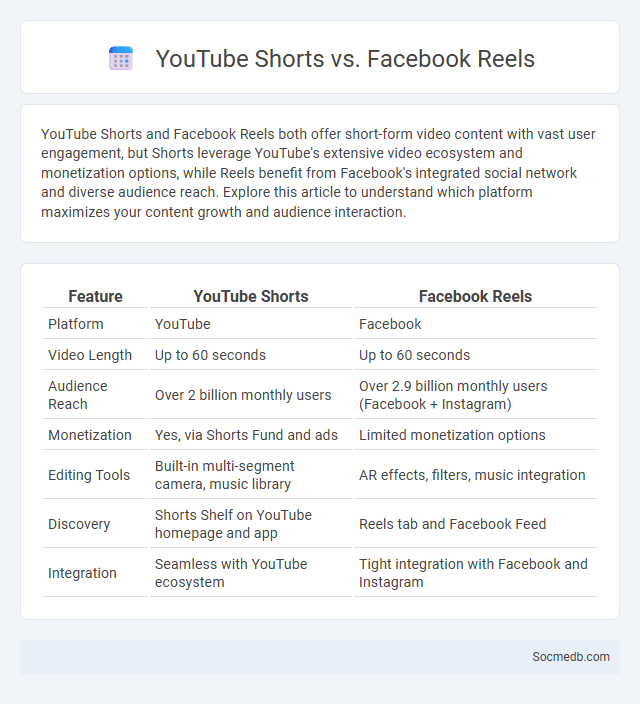
Photo illustration: YouTube Shorts vs Facebook Reels
YouTube Shorts and Facebook Reels both offer short-form video content with vast user engagement, but Shorts leverage YouTube's extensive video ecosystem and monetization options, while Reels benefit from Facebook's integrated social network and diverse audience reach. Explore this article to understand which platform maximizes your content growth and audience interaction.
Table of Comparison
| Feature | YouTube Shorts | Facebook Reels |
|---|---|---|
| Platform | YouTube | |
| Video Length | Up to 60 seconds | Up to 60 seconds |
| Audience Reach | Over 2 billion monthly users | Over 2.9 billion monthly users (Facebook + Instagram) |
| Monetization | Yes, via Shorts Fund and ads | Limited monetization options |
| Editing Tools | Built-in multi-segment camera, music library | AR effects, filters, music integration |
| Discovery | Shorts Shelf on YouTube homepage and app | Reels tab and Facebook Feed |
| Integration | Seamless with YouTube ecosystem | Tight integration with Facebook and Instagram |
Introduction to Short-Form Video Platforms
Short-form video platforms like TikTok, Instagram Reels, and YouTube Shorts have revolutionized digital content consumption by offering engaging, bite-sized videos ranging from 15 to 60 seconds. These platforms leverage algorithms that personalize content feeds, maximizing user engagement and retention through trends, challenges, and viral hits. Marketers and creators use short-form videos to boost brand visibility, drive user interaction, and capitalize on mobile-first viewing habits.
Overview of YouTube Shorts
YouTube Shorts is a short-form video platform launched by YouTube, designed to compete with TikTok and Instagram Reels by enabling users to create and share 15 to 60-second videos. It leverages YouTube's massive user base and advanced algorithm to promote viral content and increase user engagement through features like music integration, speed controls, and multi-segment video recording. As of 2024, YouTube Shorts has surpassed 1.5 billion monthly logged-in users worldwide, making it a critical component of YouTube's strategy to capture short-video market share.
Breakdown of Facebook Reels
Facebook Reels offers a dynamic platform for short-form video content, emphasizing engagement through features like music overlays, interactive stickers, and seamless sharing options. You can leverage the algorithm's preference for authentic, trending content to maximize reach and viewer interaction. Understanding the breakdown of Facebook Reels, including audience demographics and peak engagement times, is essential for optimizing your social media strategy.
Comparison: YouTube Shorts vs Facebook Reels
YouTube Shorts and Facebook Reels both serve short-form video content but differ significantly in audience reach and algorithmic exposure. YouTube Shorts benefits from integration within the vast YouTube ecosystem, offering creators potential access to over 2 billion logged-in monthly users and monetization through the YouTube Partner Program. Facebook Reels, embedded within the Facebook and Instagram platforms, leverages the combined 3 billion monthly active users of Meta's apps, prioritizing social sharing and interactive engagement features tailored to its diverse user base.
User Interface and Experience Differences
Social media platforms vary significantly in user interface (UI) and user experience (UX) design, influencing how users interact and engage with content. Platforms like Instagram emphasize visual storytelling with image-centric feeds and intuitive swipe gestures, while Twitter prioritizes concise text updates with real-time notifications and threaded conversations for rapid information exchange. Facebook combines diverse content types with customizable news feeds and extensive interaction options, optimizing user engagement through personalized algorithms and interactive elements.
Audience Demographics and Reach
Social media platforms attract diverse audience demographics, with age groups ranging from Generation Z to Baby Boomers engaging on networks like Instagram, TikTok, Facebook, and LinkedIn. Each platform offers unique targeting options, enabling brands to reach specific segments based on interests, location, gender, and behavioral data. Understanding audience reach metrics, such as impressions and engagement rates, helps optimize campaigns for maximum visibility and conversion across multiple social channels.
Monetization Opportunities and Creator Incentives
Social media platforms offer diverse monetization opportunities, including sponsored content, affiliate marketing, and fan subscriptions that enable creators to generate substantial income. Your engagement with features like ad revenue sharing, virtual gifts, and exclusive content unlocks continuous financial growth. These creator incentives motivate content innovation and foster thriving digital communities.
Algorithm and Content Discovery Mechanisms
Social media platforms rely heavily on sophisticated algorithms to personalize content feeds, optimizing user engagement by analyzing behavior patterns such as likes, shares, and dwell time. These algorithms employ machine learning techniques to curate and recommend content that aligns with individual interests, increasing content visibility and discovery through personalized relevance scores. Continuous refinement of these mechanisms ensures dynamic content delivery, improving user retention and fostering community interaction within platforms like Facebook, Instagram, and TikTok.
Analytics and Performance Tracking Tools
Social media analytics and performance tracking tools provide detailed insights into audience engagement, content reach, and campaign effectiveness, helping you optimize your marketing strategy. Platforms like Sprout Social, Hootsuite Analytics, and Google Analytics offer real-time data on key metrics such as impressions, click-through rates, and follower growth to enhance decision-making. Leveraging these tools enables your business to identify trends, measure ROI, and improve overall social media performance.
Final Verdict: Best Platform for Content Creators
YouTube stands out as the best platform for content creators due to its vast global audience exceeding 2 billion logged-in monthly users. With its robust monetization options including ad revenue, channel memberships, and Super Chats, creators can effectively earn income while building a loyal community. The platform's advanced analytics and algorithm favor engaging video content, ensuring your work reaches and resonates with the right audience.
 socmedb.com
socmedb.com